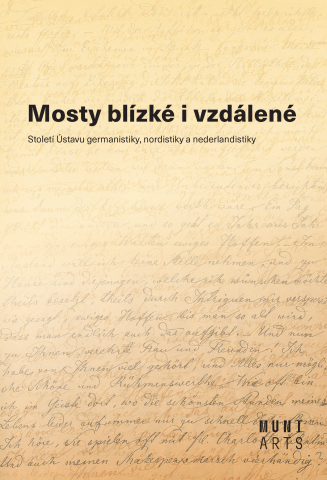Název: Mosty blízké i vzdálené : století Ústavu germanistiky, nordistiky a nederlandistiky
Variantní název:
- [Bridges near and far : one hundred years of the Department of German, Scandinavian, and Netherlands Studies]
Přispěvatel
Juříčková, Miluše (editor)
Kostelecká, Marta (editor)
Munzar, Jiří (editor)
Urválek, Aleš (editor)
Vydání
Vydání první
Místo vydání
Brno
Nakladatel
Masarykova univerzita
Rok vydání
2019
Rozsah
67 s.
Edice
- MUNI ARTS 100
ISBN
978-80-210-9252-5
978-80-210-9253-2 (online : pdf)
Trvalý odkaz (DOI): https://doi.org/10.5817/CZ.MUNI.M210-9253-2019
Trvalý odkaz (handle): https://hdl.handle.net/11222.digilib/140902
Jazyk
česky
Odkaz do knihovního katalogu MU: 6446046
Více
Anotace
- Sto let germanistiky v Brně, to je sto let zápasu o profil oboru jazykové oblasti, která je nám historicky i geograficky z filologických disciplín nejbližší. I proto se otázky spojené s oborem hned od počátku dotýkaly identity univerzity, města i celé země. Po druhé světové válce pak germanistika vystavěla mosty i ke vzdálenějším oblastem, jako jsou skandinavistika a nederlandistika. Text zachycuje nikdy nekončící snahu realizovat nové a adekvátnější metody výuky či sdílení kompetencí v proměňujících se společenských podmínkách jednoho století tak, jak se odrážejí v medailonech osobností přímo i nepřímo spjatých s germanistikou. Život a dílo zakladatele profesora Antonína Beera a jeho následovníků, aktivity profesora Josefa B. Michla, který otevřel okna germanistiky směrem k severu, stejně jako práce paní Máčelové, na niž navazuje současná nizozemština, pevně zakotvená v evropské síti oboru. Použité fotografie dokumentují také činnost zahraničních lektorů a kontakty s významnými představiteli světové germanistiky.
- One hundred years of Germanic Studies in Brno equates to a hundred years of attempting to define the profile of a philological discipline situated very close, in a historical and geographical sense, to the identity of the university, the city and the whole country. After World War II, the Department of Germanic Studies began to build bridges towards the more distant cultures of Scandinavia and the Netherlands. The text focuses on the search for new and appropriate methods of learning as well as sharing competences as long-term objectives in the developmental process, as captured in the mirror of changing societal conditions during the century. The publication presents portraits of those scientific and pedagogical personalities directly or indirectly connected to Germanic Studies, such as the life and work of Professor Antonín Beer and his successors, the work of Professor Josef B. Michl who opened up perspectives toward the north, and the work of Emmy Máčelová which has had an influence on contemporary Dutch and which is firmly anchored in the European branch of the discipline. The photographs used in the publication document the activities of foreign lecturers and our contacts with outstanding experts from the world of Germanic Studies.
Předmětová hesla
Ústav FF MU
Obor
Licence: Neurčená licence
Držitel práv
Masarykova univerzita
Přístupová práva
otevřený přístup
Upozornění: Tyto citace jsou generovány automaticky. Nemusí být zcela správně podle citačních pravidel.
| Chapter number | Title | Custom text |
|---|---|---|
| Slovo úvodem | 7–8 Urválek, Aleš |
| Chapter number | Title | Custom text |
|---|---|---|
| Jan Krejčí a Antonín Beer | 11–17 |
||
| Stanislav Sahánek – oběť nacistické zvůle | 18–20 |
||
| Poválečné hledání nové identity oboru | 21–23 |
||
| Kořeny a kontexty | 24–28 |
||
| Na cestě do současnosti | 29–30 |
||
| Dnešek ve vědě a výuce | 31–36 |
||
| Několik historických ohlédnutí | 37–41 |
||
| Závěrem | 42 Munzar, Jiří |
| Chapter number | Title | Custom text |
|---|---|---|
| Josef B. Michl | 45–48 |
||
| Libor Štukavec | 49 |
||
| Mosty k Severu | 50–53 Juříčková, Miluše |
| Chapter number | Title | Custom text |
|---|---|---|
| Hledání a utváření oboru | 57–59 |
||
| Nederlandistika se etabluje | 60–61 |
||
| Dnešní nederlandistika v evropských souřadnicích | 62–65 Kostelecká, Marta |
| Chapter number | Title | Custom text |
|---|---|---|
| Prameny a bibliografie | 67–[68] |

